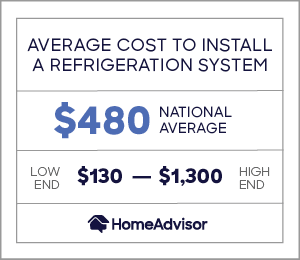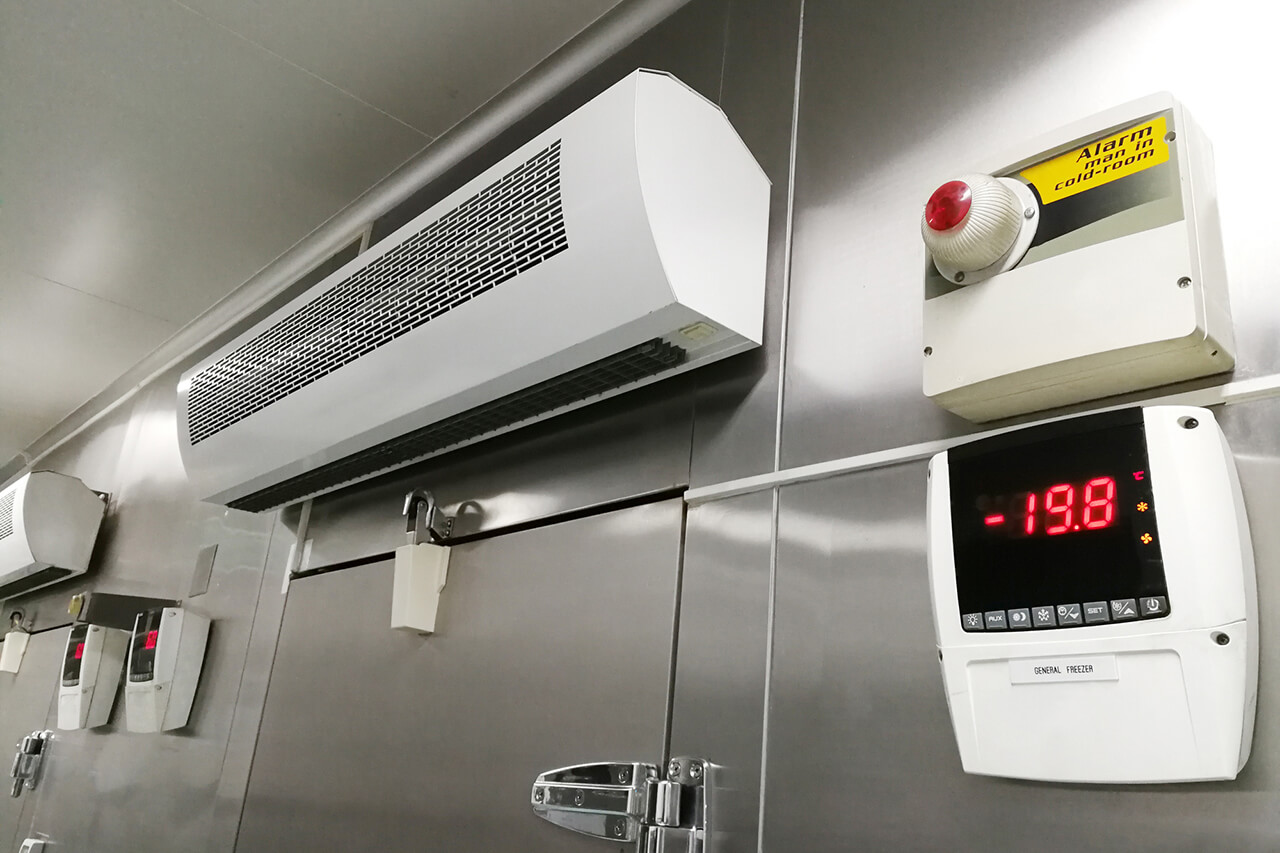How Much Does It Cost To Install A Cooling Refrigeration System?
Typical Range:
$254 - $734
Typical Range:
$254 - $734
Cost data is based on actual project costs as reported by 84 HomeAdvisor members. Embed this data
.
.
.
.
.
.
.
.
.
.
.
.
.
.
.
.
.
.
.
.
.
.
.
.
.
.
.
.
.
.
•
•
•
•
Published January 10, 2022
Written by HomeAdvisor.Residential refrigeration cooling system prices can range between $254 and $734, but most homeowners pay $494. Adding a commercial refrigeration system can cost anywhere from $1,600 to $12,000+. Refrigeration systems allow homes and businesses to store perishable items.
There are many reasons why a person would want to have a refrigeration system installed. They are used to keep food and beverages cold, create ice, and cool the air in homes, buildings and vehicles.
Let's calculate cost data for you. Where are you located?
Where are you located?
| National Average | $494 |
| Typical Range | $254 - $734 |
| Low End - High End | $125 - $1,755 |
Cost data is based on actual project costs as reported by 84 HomeAdvisor members.
Reach-In Refrigerators: $100-$2,000. Freestanding units with several doors that open up into the storage area. Common in both residential and commercial settings.
Walk-In: $1,000-$10,000+. Self-contained units. These "room refrigerators" vary in size from 10-square-feet to ware house-sized installations. Almost exclusively used in commercial spaces. Requires electrical and duct upgrades.
Under-Counter: $800-$4,500+. Like reach-in, but uses less space. Most-common in commercial kitchens and offices.
Work-top: $700-$4,000. Have a built-in work top above reach-in storage units. Common in commercial spaces.
Through-the-wall: $500-$1,600. Affordable but less efficient. Run on electricity and usually only cool a small area.
The size of your cooled space will determine the capacity and type of your unit. Cooling bigger areas will require larger and more powerful units, which will cost more to install.
Many commercial units require increased electricity. If your space isn’t outfitted with the proper hardware, you may need to install new transformers, heavier-duty wiring or updated breakers.
Some refrigeration will require ventilation and water lines. Adding or upgrading these systems will increase installation prices. Placing it near existing utilities will reduce prices. Hiring a plumber is recommended when working with pumps and vents in commercial spaces. Plumbers generally charge between $45 and $150 hour.
Certain units may not fit through doorways. This could require you to move or widen openings. Making these changes will require construction, which will increase your installation price tag. An HVAC professional can evaluate your space prior to the start of the installation to provide you with a plan, and estimated budget, for the project.
Certain businesses have different refrigeration needs:
Freezing: $400-$4,000+. Storing perishable items for long periods will require freezing. Best for restaurants or distribution businesses who store meat and vegetables.
Display: $400-$5,000+. Glass-fronted or open units give customers easy access to perishable food and drink items. Most common in restaurants and retailers.
Medical: $280-$3,000+. Medical-grade systems are designed to store sensitive materials at specific temperatures. Some units also offer freezing capabilities. Used in hospitals, doctors' offices, veterinary clinics and laboratories.
General Storage: $600-$5,000+. Storing food items for a short period of time will require basic refrigeration. Designed for restaurants and retailers like grocery and liquor stores.
Commercial refrigeration systems have a variety of manufacturer options. Here are several common considerations, each of which will affect overall costs.
Size & Unit Depth: All units come in a variety of capacities.
Type & Design: This will determine how you use your system, as well as how much it costs.
Doors: Doors on refrigeration units, especially reach-in designs, will vary in size and location. Typically designs with larger, French-style doors are priced higher.
Features: Extras like Energy Star ratings and stainless steel will also affect costs. Some units also have built-in electronics to help monitor contents and temperature.
The labor costs of your refrigeration unit will vary widely. Smaller systems like reach-in, under-counter, and work-top options runs between $250 and $850 to install. Walk-in units fall anywhere between $2,000 and $10,000+.
Refrigeration can account for up to half of the energy costs of grocery stores and some restaurants. Updating older units with Energy Star-rated systems will reduce costs. If you can't afford to purchase all new units, you can update your system's hardware (like hinges and door seals) and insulation to improve efficiency.
Commercial systems are normally larger and more robust than residential units, and more expensive at $2,000 to $10,000. Many businesses combine reach-in, work-top, and under-counter options with walk-in designs. Installing a commercial refrigeration suite can require electrical ventilation, and structural updates - especially with walk-in units.
Grocery Stores and Supermarkets: Requires large walk-in units that can range from smaller convenient store coolers to ware house-sized supermarket units. These retailers also require freezers, which can vary from doored-models to larger walk-in systems. Expect to pay premium costs for these units.
Restaurants: Walk-in and reach-in units are the most common. Some locations will also include under-cabinet and work-top systems. Freezers are also mandatory.
Bars/Breweries: Most have walk-in and display refrigeration, as well as icemakers. Breweries may have freezers depending on their brewing methods and ingredients.
Hotels: Those with a restaurant and bar will require walk-in, reach-in and freezer systems. Under-cabinet and work-top units may also be needed. Under-cabinet systems are normally in each room as well.
Schools: Require walk-in, reach-in and freezer systems. On-campus labs may also need medical-grade units.
Assisted Living Communities: Need reach-in, walk-in and freezer systems. Reach-in and under-cabinet units are also common in living quarters.
Hospitals, Doctors' Offices and Cryogenic Laboratories: Medical and scientific locales will require medical-grade refrigeration and freezers. These will range from reach-in, to under-cabinet, to walk-in systems.
Most residential units are reach-in or under-counter designs and average $250 to $880. These systems don't require electrical, ventilation, or layout updates. Most home installations take only several hours.
Homeowners who choose to install a wine cellar or cave in their homes can choose between expensive walk-in options, or affordable reach-in and under-counter units. The cost of the unit will vary based on the space of your cellar and the number of bottles you plan to store.
Smaller units can also benefit beer lovers or entertainers looking to store chilled bottles.
Upgrading older reach-in models with energy efficient alternatives is also a popular residential upgrade. New units offer homeowners increased space, efficiency and features like Wi-Fi connectedness and touch-screens.
These types of cooling systems are used for air conditioning rather than refrigeration.
Ductless units can cool a large area and do not require the installation of any duct work in the home, making this an ideal option for older homes and buildings. They require the installation of air handling units in each room, which allows for independent temperature control. You can expect to pay $6,000 t=to $12,000 for these systems.
Ducted units rely on pre-existing or newly installed duct work and vents to carry cold air throughout the space. They use one air handling unit and distribute cooled air using the ventilation system, which cost a little over $1,000 to install on average. This will result in each room being the same temperature. Installation of ducted air conditioning units cost between $3,000 and $5,000.
Refrigerant is cycled through the compressor, which increases the pressure. This allows the coolant to flow through the condenser. The condenser is then converts the refrigerant from a vapor to a liquid.
Next, the liquid refrigerant is sent through an expansion valve, which reduces the pressure and vaporizes it. The evaporator can then draw in air from the area that needs to be cooled, causing the temperature to drop. This process continues in an ongoing cycle for as long as the refrigeration system is running.
Refrigeration systems can be useful in homes and restaurants alike. For example, those who have a bar or want to build one will need a system to keep beer, mixers and other drinks cold. Furthermore, a refrigeration system can include an ice maker, which is a must for making drinks.
Even those who don't need a full bar can benefit from a refrigeration system. For example, those who like to enjoy an ice-cold beer from time to time may want to invest in a beer cooler with a quality cooling system. It is also a must for those who want to install a wine cellar. After all, many wines need to be chilled to a perfect temperature in order to be enjoyed to their fullest extent.
For those who enjoy tobacco, a cooling system will keep cigars and loose-fill moist.
Get a call from an HVAC Installation Pro

